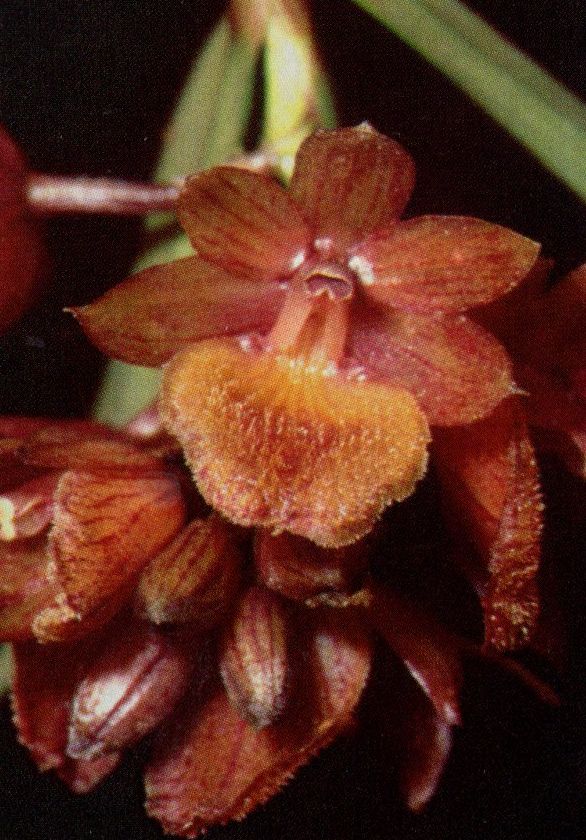

Epidendrum arevaloides Hágsater & Dodson 2004 GROUP Diothonea SUBGROUP Diothonea
Photo by © Alexander Hirtz
TYPE Drawing by © Jimenez, Hágsater & E.Santiago and The AMO Herbario Website




Common Name The Arevaloi-Like Epidendrum
Flower Size .6" [1.5 cm]
Found in Ecuador in wet montane forests at elevations of 1850 to 2780 meters as a medium sized, cool to cold growing epiphyte with erect, simple, cane-like, thin, terete stems producing new stems from the apical internode of the previous stem and carrying 4 to 9, on the apical 1/2 of the stem, narrowly lanceolate, bilobed to unequally bilobed, entire margin leaves that blooms in the fall on a terminal, racemose, erect to arching, occuring only once, terete, thin, .6" to 1.2" [1.5 to 3 cm] long, several to many flowered inflorescence with triangular, long-acuminate, as long as, to shorter than, the ovary floral bracts carrying 8 to 17, simultaneously opening, green to green-yellowish, reddish to rarely pinkish flowers.
"Epidendrum arevaloides belongs to the GROUP Diothonea SUBGROUP Diothonea which is characterized by the branching plants, linear lanceolate to oblong, bilobed leaves, racemose, arching-nutant inflorescence, membranaceous flowers (rarely fleshy), the entire to 3-lobed, ecallose lip with the margin erose with or without 1 to 10 thin, smooth to erose keels, the column completely to obliquely united to the lip, the anther reniform. The new species is recognized by the thin, terete stems, branching towards the apex, short, arching inflorescence, narrowly lanceolate leaves distributed towards the apical half of the stems, obtuse petals .268 to .4" [6.7 to 10 mm] long, sepals 3-veined, lip ovate to suborbicular, ornamented with ancistrous trichomes on the apical half, thin, straight, free column with a pair of narrow lateral wings along the basal half; the column is .2 to .24" [5 to 6 mm] long. It is similar to Epidendrum arevaloi which has larger plants, longer leaves, the veins of the floral segments marked red, larger f1owers, the acute petals, the sepals .48 to .64" [12 to 16 mm] long, the lip provided with 9 to 10 keels evidently serrulate towards the apical half. Epidendrum cochabambanum Dodson & Vásquez has linear, conduplicate leaves .08 to .12" [2 to 3 mm] wide, smaller f1owers, narrowly linear-elliptic petals, the lip totally united to the column is provided with 5 laminar, smooth keels and the column thick and widening towards the apex. Epidendrum microdiothoneum Hágsater & Dodson has a glomerulate inflorescence, ventrally thickened ovary along the apical 2/3's, elliptic, petals 3-veined, the veins much branched, 3-lobed lip provided with 4 laminar keels, column short, .12" [3 mm] long. Epidendrum heterothoneum (Rchb. f. & Warsc.) Hágsater has larger f1owers, the floral segments .6 to .64" [15 to 16 mm] long, 3-lobed lip totally united to the column which is thick and widened towards the apex. Epidendrum megalospathum (Rchb. f.) Garay & Dunsterv., though belonging to a different group with a very different plant architecture and a promlnent spathe and has a similarly free column." Hagsater etal 2004
Synonyms
References W3 Tropicos, Kew Monocot list , IPNI ; Native Ecuadorian Orchids Vol 2 Dodson 2001 #551 as E heterothonaeum photo fide; *Icones Orchidacearum 7 Plate 706 Hasater & Salazar 2004 drawing fide; Icones Orchidacearum 7 Plate 726 Hagsater and Sanchez 2004 see recognition section; Orquideologia Vol 24 #1 2005 photo fide; Icones Orchidacearum 8 Plate 809 Hagsater and Sanchez 2006 see recognition section; Icones Orchidacearum 8 Plate 819 Hagsater and Sanchez 2006 see recognition section;
--------------------------------------------------------------------------------------------------------------------------